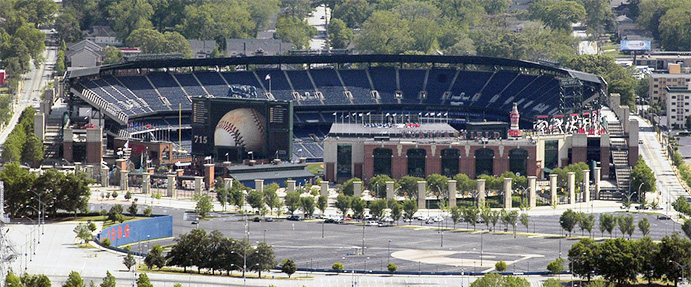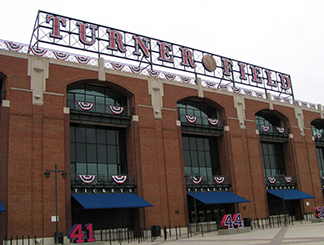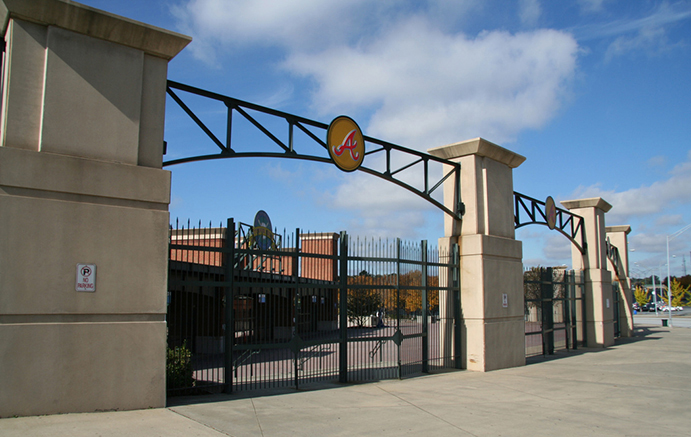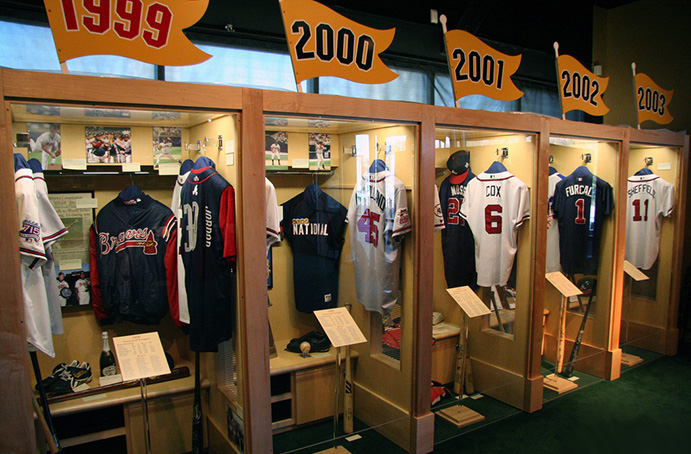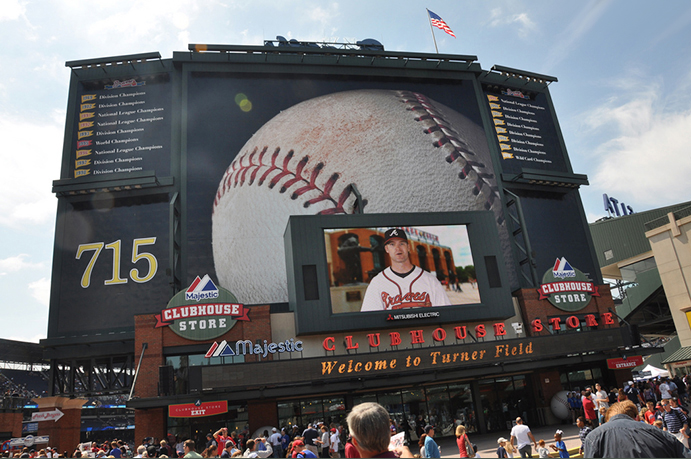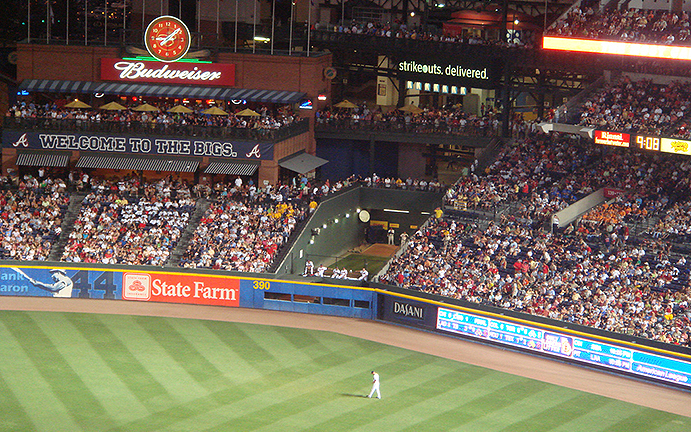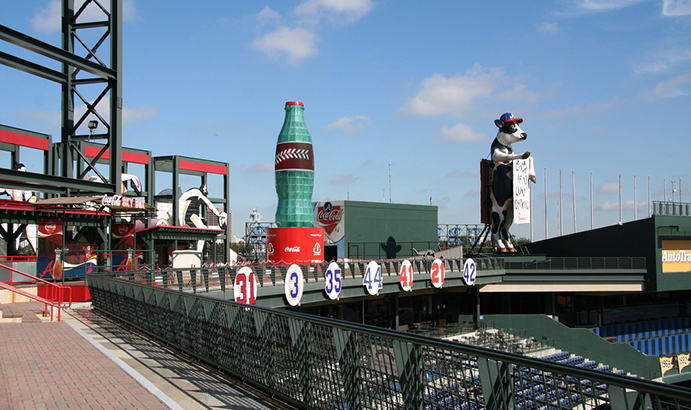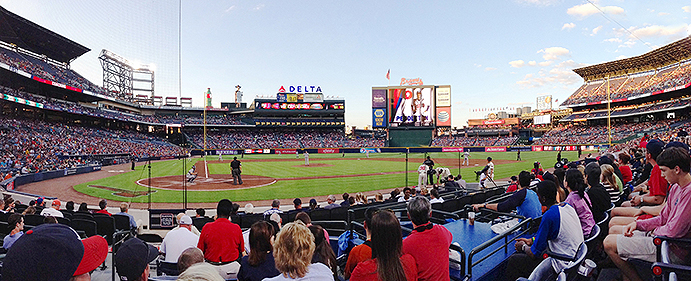The Ballparks
Turner Field
Atlanta, Georgia
(Flickr—Valerie Abbott/Ucumari Photography)
How do you conceive and build a track and field facility for the Summer Olympics, tear it apart afterwards and convert it to a ballpark? Ask the folks in Atlanta, where running tracks became warning tracks, ovals became diamonds, and flags became foam tomahawks. A year after its opening, Olympic Stadium would become Turner Field, and on its stage the Braves would replace the world’s athletes and extend its reign of excellence.
They came in through the back door at Turner Field, into an expansive plaza drenched in history both recent and distant. Concrete columns spaced some 25 feet from one another lined the outer borders of the plaza as a reminder of the ballpark’s original but temporary use as an oval stadium that welcomed over 2,000 of the world’s greatest athletes participating in the grandest sports event of them all. Within this arc of columns, baseball took over the podium—with bronze tributes to golden legends and a massive photographic beacon that’s an ode to one of the game’s greatest moments from Atlanta’s most popular baseball hero, one Henry Louis Aaron.
When “The Ted” became an afterthought as the Braves bolted for the suburbs, it wasn’t remembered for its unique character. But it was recalled for the unique circumstances under which it was conceived and constructed.
Fast rewind to the mid-1980s. The burst of popularity that the Braves enjoyed from a breakout 1982 postseason campaign, through the lens of the local cable “superstation” that gave it nationwide coverage, was starting to temper. Dubbed “America’s Team”—stealing from football’s Dallas Cowboys—the Braves were sinking back in the standings; there was only so much Dale Murphy could do. As the losses mounted, attendance sagged. That’s the thing about Atlanta pro sports; when a team wins, the fans will drop everything and rush to the ticket booths—but will stay away in droves when it loses.
Atlanta-Fulton County Stadium was once a welcome setting for the Braves after their controversial departure from Milwaukee, but that was 20 years earlier; the team was now growing restless in a facility becoming increasingly passé as other teams began drawing up blueprints for the next wave of modern ballparks.
The Braves knew full well that most of their fan base was located on the other side of town, in the relatively wealthy northern suburbs. They also knew that those fans were loathe to crawl through Atlanta’s notoriously clogged traffic to reach a place adjacent to one of the city’s more crime- and drug-infested neighborhoods. So they began the thought process of building a new ballpark closer to those ‘burbs.
But out of left field came an unexpected and utterly fortuitous alternative.
Sparking the Summer Flame.
In 1987, an ambitious 40-year-old local lawyer named Billy Payne thought up a crazy idea: Have Atlanta bid on the 1996 Summer Olympics and try and steal it from Athens, a slam-dunk favorite given its distinction as birthplace of the Olympic spirit coupled with the 100th anniversary of its hosting the first modern Games. Maybe Payne was thinking of Athens, Georgia, and not Athens, Greece.
As Payne took charge of the Olympic effort and began building up a financial war chest without a dime of public expense, he began looking at what new facilities would be needed and which existing ones could be spruced up, if need be, for the Games. Topping his priority list was where to put the mothership, an Olympic stadium that would host the opening and closing ceremonies as well as the marquee track and field events. The downtown-based Georgia Dome, home of the NFL Falcons, had the seating capacity but could not be plausibly converted for track and field. Then there was Atlanta-Fulton County Stadium, which lacked the necessary oval presence—but Payne saw the eight square blocks of land to the south and east, the majority of which was used for stadium parking, and decided to hit up Braves president Stan Kasten with an idea: How about if we tore down Atlanta-Fulton, built an Olympic stadium to the south and, when the Games were over, quickly transform the oval structure into a pure baseball park—all at little or no cost to the Braves?
Kasten must have rubbed the inside of his ears to make sure he heard right. Here was someone telling him that a private group was willing to reconstruct a ballpark from a stadium without any public financing, and gift it to the Braves. It was, as Kasten later put it, “the break of a lifetime.”
Payne had his reasons for such generosity; the more sporting venues that would see active life beyond an Atlanta Olympics, the more likely the odds of approval from local government who needed to justify maintenance and upkeep costs. He even promised Olympics funds to pay off the remaining debt on Atlanta-Fulton County Stadium.
Kasten, too, needed some convincing. He knew that major league teams had twice tried to wedge themselves into stadiums built for the Olympics: The Los Angeles Memorial Coliseum, where the Dodgers had to put up a driving range-style net behind a ridiculously short left field to prevent cheap home runs; and Montreal’s overpriced and flawed Olympic Stadium, where the Expos floated about as if inside a broken-down spaceship. Kasten wanted to make sure that the stadium-turned-ballpark would be a true baseball facility where the Braves and their fans would feel at home, instead of strangers in a strange land.
There was also the issue of location; the new ballpark would still be in a rough part of town. Payne saw to that, proposing that the Olympics project would include gentrification of the neighborhood with new tracts of middle-income townhouse developments.
Of course, all of this would be moot if the International Olympic Committee didn’t give Atlanta the Games. On September 18, 1990, Athens was expected to be the word. Instead, it was Atlanta. Apparently, the pecan pies went over well with the IOC inspectors.
The outer edges of Monument Plaza—which most fans walked through to enter Turner Field—is lined with concrete pillars which once held the temporary seating for Centennial Olympic Stadium. (Flickr—Peter Bond)
A Five-Ring Circus.
In the wake of the delirium over Atlanta’s upset victory, Payne and the Braves anticipated an easy, downhill ride toward a new Olympics stadium/ballpark. Little did they realize that the hard part was just beginning.
Community leaders feared and protested the possibility of stadium construction and ballpark reconstruction commencing without neighborhood representation. Other nearby residents brooded over the influx of construction equipment and the noise pollution it would create. More incredulously, the Fulton County Commission decided that an Olympic facility/Braves ballpark built completely from private funds wasn’t good enough for them. It wanted insurances that the Braves would pay their fair share of maintenance through their 20-year lease of the ballpark, plus an annual rent of $500,000. A flabbergasted Kasten told the New York Times, “What do they need the rent for, Christmas parties?”
The Braves conceded much, and still the negotiations went down to the wire. Talks became so intense, Payne was ready to pull the plug on building next to Atlanta-Fulton County Stadium and move the whole show to the northern suburbs, with the Braves agreeably in tow. “I never worked so hard to give away a $207 million stadium in my life,” Payne told local sportswriter Gary Caruso, stressing the stress that may have led him to undergo open-heart surgery—his second—as stadium talks neared their conclusion in the spring of 1993.
Initially idealized as being situated cattycorner from where Turner Field now stands—before that was deemed too close and distractive to nearby residences—Centennial Olympic Stadium would be built in under three years, just in time for the Olympic flame to arrive in Atlanta and light up the cauldron to officially begin the Games. Contrary to layman’s thought, the facility was designed with baseball in mind, transformed on blueprint and then built as Centennial Olympic Stadium as a more temporary structure before being ‘reconverted’ back into a ballpark.
The Braves Museum and Hall of Fame at Turner Field included locker stalls representing each of the team’s 14 straight divisional titles from 1991-2005. (Flickr—Peter Bond)
The Seven-Month Dash.
As the 1996 Summer Games drew to a close, the Braves grew more anxious of the unprecedented feat that lay ahead. Even with the extinguishing of the Olympic flame, the reconstructionists still had to sit tight; the Paralympics followed, not to be finished until September 1. That left less than seven months—overnight, in contractor-speak—for the Braves to partially break down Centennial Olympic Stadium and rebuild it as Turner Field. It all seemed a logistical nightmare at best and impossibility at worst—an ambition of madness, like Klaus Kinski trying to haul a boat over a mountain in Fitzcarraldo. Construction experts looking in from the outside shook their heads at the expedited schedule and concluded that it couldn’t be done. The Braves themselves weren’t so sure; they told the demolition experts salivating at the gates of abandoned Atlanta-Fulton to hold off pressing down on the detonator, just in case.
The design team in charge of the project came with a strong backbone of ballpark-building experience. Kansas City-based Ellerbe Becket, in the midst of developing the retractable-roofed Bank One Ballpark (now Chase Field) in Phoenix, was the lead architect, while the Braves scored a coup in luring away the tireless, meticulous Janet Marie Smith from Baltimore (where she was a major force in realizing Oriole Park at Camden Yards) to oversee the vision laid out by Ellerbe and the Braves and make sure that all the architectural i’s we’re dotted and t’s crossed—and on time.
From the air, Centennial Olympic Stadium had the look of an oval with a ballpark trying to take shape and break away at the south end. That would be the main, three-level ballpark bowl that would largely remain after the Olympics; the more traditional, single-level oval at the north end would see the short life, dismantled along with an extended second deck behind where right-center field now exists, and an extended press area within what is now second-level seating along the left-field line. In all, 35,000 seats were purged.
Heavy winter rains made progress on the reconstruction a challenge. The worst headache was a ground base for the playing field that had become a giant mud pit; helicopters were summoned in a futile attempt to dry it down. Nervous crews reached a fail-safe point where more rain could have threatened Opening Day, but fortunately the skies cleared for the long run and allowed the installation of turf, trucked in from a Florida sod form owned by golfer Greg Norman. The choppers, meanwhile, had better success pegging in the foul poles after the existing structure made it difficult to have them brought in by ground.
Turner Field would be constructed mostly of steel, brick and limestone—materials seen at many other recently built “retro” ballparks—but the Braves wanted Turner Field to be defined in a different light. Kasten reiterated this tact by stating the ballpark shouldn’t be classified as nostalgic but, instead, “classic.”
Of the many tributes to Hank Aaron at Turner Field, none was more prominent than the gigantic image of his 715th career home run ball, located on the opposite side of the main scoreboard. The actual ball, and the bat Aaron used to hit it, was also on display at the nearby Braves Museum and Hall of Fame. (Flickr—Kyle James)
The Braves would ultimately fork over $45 million—a third of which came courtesy of a loan from ballpark concessionaire Aramark—to help with the transformation. Rather than recoup more of the expenses through ballpark naming rights, Braves management developed a sentimental touch and named the ballpark after Ted Turner, the Atlanta-bred CNN creator, America’s Cup yachtsman, crusader of colorized movie classics, Braves manager for a day (in 1977) and Braves owner for 20 years until Liberty Media purchased the team in 1996. It’s understandably assumed that Turner’s ego drove the venue’s name, but he neither lobbied for nor was directly involved in the decision.
Turner would throw out the ceremonial first pitch for the inaugural game at the transformed facility now bearing his name; Hank Aaron emerged from center field and, with Braves pitcher Tom Glavine, brought the home plate from Atlanta-Fulton County Stadium to its rightful new spot. The game to follow made for a thrilling debut; trailing the Chicago Cubs after the seventh-inning stretch, 4-2, the Braves rallied for one run followed by two more in the eighth to take the lead as Chipper Jones’ single brought home the ultimate game-winning run in a 5-4 victory before 45,044 entertained fans.
There were the usual hiccups that led to post-Opening Day tweaks. The direction of some lights had to be adjusted after outfielders complained of glare that made routine flies difficult to track. The dugout rails were initially positioned in a way that made viewing the action challenging, and it especially perturbed Braves manager Bobby Cox, the man on his way to setting a career record for ejections. Given his testy reputation, the design team wasn’t about to debate the subject with Cox and made the corrections.
And while Turner Field looked complete from the outside, little did fans know that the conversion to baseball continued under the stands. The greenskeepers certainly knew; their offices and storage areas were among the last to be put together, well after the first games had been played.
New Place, Same Success.
The opening of Turner Field saw the Braves in much better times than 10 years earlier when the ballpark was first idealized by Billy Payne. The team had performed a remarkable about-face in 1991, going from worst to first and winning the National League pennant; in the next (and final) five years at Atlanta-Fulton County Stadium, they finished in first place every season but one (the strike-shortened 1994 campaign), won three more pennants and, in 1995, their first world title in 38 years. The Braves’ relocation to Turner Field didn’t slow the momentum; they were 50-31 at home in 1997, followed by exceptional 56-25 marks in both 1998 and 1999. Early murmurs that the new ballpark would be a hitters’ paradise a la Coors Field were quickly eased as Turner Field proved to be quite fair, leaving it to the smarter ballplayers to take advantage of whatever strengths could be found in near-symmetrical dimensions that played roughly 330-335 feet down the lines, 380-390 into the gaps and 400 to straightaway center—all with equal fence heights and no blunt angles for outfielders to be wary of.
The Braves’ winning ways played a role in keeping attendance over three million in Turner Field’s early years, but the lure of the facility and all of its baseball-related bells and whistles certainly had something to do with the high fan count as well.
Behind the right-center field fence lay the Braves’ bullpen; to the left, the Chophouse dining area. The slight change in direction to the right of the 390 marker was about as close to a blunt angle as you’ll find along Turner Field’s outfield wall. (Flickr—D.L.)
Earning an A For Aaron.
It was impossible—and rightfully so—for fans to approach, arrive and enter into Turner Field without being reminded of legendary Braves hero Hank Aaron. The stretch of Capitol Avenue that passed by the ballpark’s front gates was renamed Hank Aaron Drive (with Turner Field’s address listed as 755); in the northern parking lot where Atlanta-Fulton County Stadium once stood, a segment of the fence and bleacher wall—where Aaron hit the home run to break Babe Ruth’s career home run mark—remains the last physical remnant from the old venue; there was both a bust and a statue of Aaron in Monument Grove, part of an extensive collection of bronze that also includes sculpted tributes to Georgia native Ty Cobb and Braves pitching legends Warren Spahn and Phil Niekro; and once past the plaza and inside the gates, you came face-to-face with a 100×100-foot photographic image of Aaron’s 715th home run ball emerging like a giant harvest moon peaking over the horizon on a warm summer evening.
Around the 715 image was the ballpark’s inner greeting grounds, an area that opened up triangularly toward the main concourse and surrounded by enough attractions to confuse it with an upscale state fair. To the left, there was a food court; to the right, there was the Taco Mac Family Zone, full of play structures and interactive exhibits primarily for the children while the parents hung out and look at their watches; and straight ahead under the 715 image was the Braves Clubhouse Store, fronted by a series of monitors showing all other major league games in progress.
Past the 715 image—plastered on the flip side of the scoreboard—fans discovered that all of Turner Field’s peripheral action took place behind the outfield wall. Behind right-center was the Chophouse, a casual, multi-tiered restaurant serving the basics but best known for its smoked turkey legs. Closer to left was The 755 Club, a more posh setting for members only.
Nearby was the Ivan Allen Jr. Braves Museum & Hall of Fame, a treasure trove of Braves-related artifacts going back to their 19th-Century days in Boston. (“Ivan who,” you may be asking? He was the Atlanta mayor who helped swipe the Braves away from Milwaukee.) Mementos ranged from Aaron’s 715th home run ball and the bat he used to belt it (sorry, Cooperstown) to more curious items such as Warren Spahn’s purple heart, Andy Messersmith’s “Channel 17” uniform (a shameless on-field plug for Ted Turner’s TV station in the 1970s), and the knee brace worn by Sid Bream when he famously lugged himself home to win the 1992 NL pennant for the Braves. Perhaps topping them all was an actual railroad car plunked into the museum—it wasn’t easy putting it there—dressed up and similar to one used by the Milwaukee Braves in a time before jetliner travel became common.
Turner Field wasn’t all about Hank Aaron. Wrapping around the left-field foul pole from the upper concourse, Coca-Cola Sky Field held court because you simply couldn’t have a ballpark in Atlanta without locally based Coca-Cola having a major presence somewhere. Outside of a nice view of downtown Atlanta and a baseline strip for kids to time their 90-foot dashes, this outdoor pavilion was low on frills but did perform brand overload with, among other things, cannons shaped as Coke bottles that shot out streamers when a Braves player went deep, and a 42-foot Coke bottle adorned with 6,680 baseballs, 290 bats, 86 gloves and 64 bases among many other baseball-related items. Although the equipment was all apparent up front, from further away it looked like something Pocahontas would have worn had she been shaped like a soda bottle. The bottle would eventually be stripped down without all the gear and came off more like the Real Thing.
Turner Field’s sideshows came to a halt once you walk the open concourses past the foul poles toward home plate. Here, the mallpark became a true ballpark and focused primarily on baseball, with the exception of a series of colorful local art displays and a timeline of old Atlanta-Fulton County Stadium. There was a purpose to this imbalance of mixed-use entertainment; everybody parked north of Turner Field, and it’s from there that everyone entered. Not only did Monument Plaza consume the majority flow, so did two giant staircases on the west and east ends that fed fans to and from the upper two levels. Few people used a home plate entrance unless they were guests from the few chain hotels nearby or residents from the neighborhood to the south.
The Coca-Cola Sky Field, located above the left-field corner, proved short on frills but heavy on Coke branding. Its backside provided the best views of downtown Atlanta from Turner Field. (Flickr—Peter Bond)
The Heroes of Turner.
The Braves’ run of unprecedented success in the standings continued well into Turner Field’s lifespan. In the team’s first nine years at Turner, it won nine NL East divisional titles and recorded a stellar 462-266 regular season record at home. Much of that was attributable to the so-called “Big Three” triumvirate of Atlanta aces—Hall of Famers Greg Maddux, Tom Glavine and John Smoltz—who flourished in the semi-spacious dimensions of their new home. Maddux pitched the first seven years at Turner and turned in a sparkling 72-30 record and 2.65 earned run average; Glavine was 49-24 with a 3.30 mark before his departure in 2002; and Smoltz won 52, lost 30, authored a 2.95 ERA and saved 154 games in a brief (and very impressive) four-year spell as the team’s closer.
At the plate, no Braves player profited more from Turner Field than third baseman Chipper Jones. In 1,119 career games spread over 16 years at Turner, the sociable, often strident switch-hitter batted .315 with 226 home runs; in the 2000 All-Star Game—the only one held at Turner Field—Jones went 3-for-3 with a home run. Turner Field may be known as The Ted and could be thought of as the House that Billy Payne Built Twice, but if the ballpark ever meets the wrecking ball, it must be imagined that a little bit of Chipper Jones will die with it.
The Braves’ annual winning ways became so routine, it led to a complacent atmosphere at the ticket window. That, along with the gradual evaporation of the new ballpark smell, put Turner Field attendance on a downward slope with yearly gates settling in at (and sometimes below) 2.5 million. Not helping was the Braves’ frustrating inability to succeed in October; despite all those divisional titles, the team was only 14-17 in the postseason and secured only one NL pennant (in 1999). A regeneration of talent and a revival of team fortunes in the 2010s brought only more bad luck at home; it lost both NLDS home games to San Francisco in 2010, and two years later bowed in the first-ever NL Wild Card “play-in” game, held at Turner Field, with a controversial 6-3 loss to St. Louis. The fans, becoming wary of the Braves’ October blues, perhaps didn’t want to bear witness to it all; postseason sellouts were far from a sure thing, and at times whole swathes of empty seats could be found in Turner Field’s upper deck. It all hit a low in Game Five of the 2001 NLCS when the Braves attracted only 35,652, 15,000 shy of capacity. (And of course, they lost the game.)
Beyond the postseason, some of Turner Field’s great moments were turned in by visiting players. Arizona’s Randy Johnson threw a perfect game against the Braves in 2004. Six years later, Ubaldo Jimenez threw the first no-hitter in Colorado Rockies history. Four Philadelphia pitchers combined to throw a no-no in 2014. Barry Bonds came to town in the ballpark’s first decade and tore apart Atlanta pitching with a .352 clip and 14 homers in just 34 games. And despite Chipper Jones’ 3-for-3 at the All-Star Game, the National League still lost—with the game’s MVP going to Derek Jeter, who in 11 regular season visits to Turner Field batted .412.
Everything New is Old Again.
By the early 2010s, the mood within the Braves’ front offices seemed to be coming full circle. The same complaints heard 25 years earlier being cropping up again from the fans and team brass alike: A long haul from the suburbs, bad traffic, dangerous surroundings. It had been tolerated with the excitement of the new ballpark, but once the yawns began to follow, the gripes grew anew.
Mass transit options to Turner Field were passable at best. And all that middle-class development promised around the ballpark? Some of it came, but community cohesion remained stagnant with most nearby businesses boarded up and scrawled with graffiti. One attempt to inject entertainment outside of the ballpark failed when FanPlex, a miniature golf course/video game complex, opened in 2002—and closed in 2004, in part because they had built it on the wrong, quiet side of Turner Field. Unlike many other new ballparks, gentrification did not win the day here.
The Braves generally drew well at Turner Field, but no-shows and empty postseason seats were a problem. (Flickr—LW Yang)
For most fans who come to Turner Field, the agenda was very simple: Get in, enjoy the game and the park, and get out. Little wonder that the Braves dressed up the joint with “101 things to do” besides watching baseball.
But there’s something else. Turner Field never quite captured the imagination of baseball fans comparing modern ballparks to one another. It was nice and pleasing, but much of its charm was manufactured and not truly original; there’s no genuine signature asset to be found, like the San Francisco Bay or the Pittsburgh skyline or the Green Monster. Some of that could be attributed to a lack of visual culture within Atlanta, or as former Braves PR director Bob Hope once told the Atlanta Journal Constitution: “We don’t have a great sense of heritage.” Gee, Bob, thanks for the memories.
Even for the hardcore baseball fans who wasn’t interested in Warren Spahn’s purple heart or a giant Coke bottle or the 755 Club, Turner Field played too laid back. Sightlines were some of the most distant among the retro-era ballparks; here, intimacy was in short supply.
The Braves were handed a free ballpark and got 20 years out of it, pumping in $125 million in upgrades over this span of time. They knew the next 20 years wouldn’t be so cheap. A wish list was developed of how to freshen up the park, but the Braves concluded it was going to cost $350 million, nearly double what it cost to build and rebuild Centennial Olympic Stadium/Turner Field. Atlanta mayor Kasim Reed might have said yes to helping out, but he had already gone all in on a new stadium for the Falcons. He claimed he simply had no available funds for a Turner Field makeover.
On November 11, 2013, the Braves announced that they would leave Turner Field—at the time, the majors’ 17th oldest ballpark—after the 2016 season for a proposed new ballpark. Location: Cobb County, north of Atlanta and a much shorter drive away from the bulk of the Braves’ fan base. The news gave the modern “retro” ballpark boom a twinge of middle age reality.
Turner Field has not faded away or, worse, met the wrecking ball. Georgia State has taken over as the chief occupant, reimagining the ballpark as a 24,000-seat football stadium; many of the original seats remain, but they’re either tarped over or without a view of the gridiron. It now goes by the name of, generically enough, Georgia State Stadium.
As a ballpark, Turner Field’s 20-year lifespan was the shortest of any facility built exclusively for a major league team over the previous 100 years. Maybe it’s not how Billy Payne, currently in Augusta as chairman of one of the world’s most famous golf clubs, envisioned his Olympic pet project. But at least he feels a modest amount of comfort in that he can always revisit the joint and remember it for all it was.
 The Ballparks: Atlanta-Fulton County Stadium Strategically placed south of downtown near the nexus of three major Interstates, Atlanta-Fulton County Stadium ran hot and cold—and sometimes just plain weird, given the promotional lunacy born out of Ted Turner’s early years running the Braves. But the modern venue, efficiently propped up with staggering speed, catapulted the Peach City from overgrown drudgery into the big leagues, helping to cement its standing as the Hub of the New South.
The Ballparks: Atlanta-Fulton County Stadium Strategically placed south of downtown near the nexus of three major Interstates, Atlanta-Fulton County Stadium ran hot and cold—and sometimes just plain weird, given the promotional lunacy born out of Ted Turner’s early years running the Braves. But the modern venue, efficiently propped up with staggering speed, catapulted the Peach City from overgrown drudgery into the big leagues, helping to cement its standing as the Hub of the New South.
Atlanta Braves Team History A decade-by-decade history of the Braves, the ballparks they’ve played in, and the four people who are on the franchise’s Mount Rushmore.


